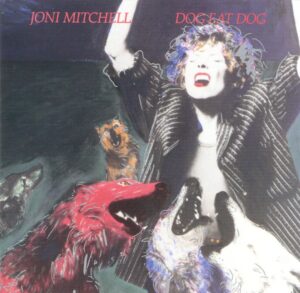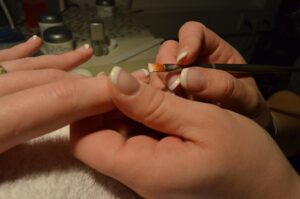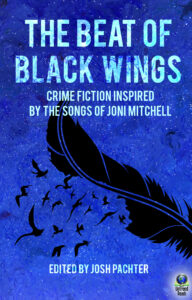
By Elaine Viets
This month got off to a pleasant start. My short story, “Dog Eat Dog” was nominated for two awards: the Macavity and the International Thriller Writers.
The story was in The Beat of Black Wings, an anthology based on the songs of Joni Mitchell. I chose “Dog Eat Dog.”
 This story was difficult to write, because my protagonist was so dislikeable. We learn straight out that Tiffany Yokum is a gold digger – and a calculating killer.
This story was difficult to write, because my protagonist was so dislikeable. We learn straight out that Tiffany Yokum is a gold digger – and a calculating killer.
Here’s her introduction:
“The first time I tried to kill my husband, I failed. Miserably. I gave him a little push at the top of the stairs and Colgate tangled himself in his walker and fell down twenty-seven marble steps, just as I hoped. And he cracked his head – but not hard enough.
“Now he’s in a coma. The doctors say there’s still brain activity and he could wake up at any time, so I can’t pull the plug. He could live forever this way. As I sit by his bedside, I watch the fluid drip through his IV, and imagine each drop is a dollar. Even his immense fortune will be drained away.
“I want desperately to finish him off, but I don’t want to get caught.”
Greedy Tiffany put a nice old man into a coma, and now she wants him to die. How do I make readers root for this little moneygrubber?
Unlikeable protagonists are extremely popular, thanks to Gillian Flynn’s Gone Girl. Before Gillian, there was the disgusting pedophile Humbert Humbert in Lolita. And Rabbit Angstrom in John Updike’s Rabbit, Run and other novels in this series. Books I pretended to read in college but couldn’t finish because I found Rabbit, the protagonist, self-absorbed and dull.
Short stories don’t have time to create the subtleties of a novel. Which gets us back to Tiffany and how to make readers root for this crafty killer. Here are some ways to do it.
Give your villains a minor illness.
 The award-winning Evan Hunter – a.k.a. Ed McBain – made that recommendation. It works if your villains aren’t too evil. McBain had a lot of sniffling and sneezing detectives in the 87th Precinct. But I could give Tiffany pneumonia – heck, Covid-19 – and she still wouldn’t be likeable.
The award-winning Evan Hunter – a.k.a. Ed McBain – made that recommendation. It works if your villains aren’t too evil. McBain had a lot of sniffling and sneezing detectives in the 87th Precinct. But I could give Tiffany pneumonia – heck, Covid-19 – and she still wouldn’t be likeable.
Give your villains a sympathetic background.

Tiffany is by no means her rich husband’s social equal. She’s an 18-year-old clerk at a hardware store in Festus, Missouri. “Colgate Osborne was a randy seventy-two when he first spotted me behind the cash register, falling out of my tank top,” Tiffany says. She grew up in a trailer park. So she’s at the bottom rung of the ladder, looking to climb. Readers like to root for a rags-to-riches scenario.
Make your villains smart. Or at least crafty.
 Tiffany quickly becomes the fourth wife of rich old Cole Osborne and they live in luxury in Fort Lauderdale.
Tiffany quickly becomes the fourth wife of rich old Cole Osborne and they live in luxury in Fort Lauderdale.
“I never went to college, but I wasn’t stupid,” Tiffany said. “I knew now that Cole had tied the knot with me, my struggle had just begun. Cole was very, very classy, and I had to fit in with his rich friends.”
Make your villains self-aware.
 The Joni Mitchell song was Tiffany’s anthem, and she recognized herself in the lyrics of “Dog Eat Dog.” Especially the part about slaves. Some were well-treated . . .
The Joni Mitchell song was Tiffany’s anthem, and she recognized herself in the lyrics of “Dog Eat Dog.” Especially the part about slaves. Some were well-treated . . .
And some like poor beasts
Are burdened down to breaking
Tiffany said, “This was a dog eat dog world – more so than the trailer park where I used to live. I was a well-treated slave, and I’d sold myself into slavery, but I knew that.”
Our villain has knows she’s living in comfort, but she can’t get comfortable.
“One misstep, and I’d be one of those poor beasts, working again at the local hardware store or greeting people at Walmart. I had a prenup that would give me a measly hundred thousand dollars if we divorced, but if I could hang on until Cole died, I’d get half his fortune.”
Make your villains work for their success. That way, readers can root for them.
 Cindy knew she’s landed her pretty derriere in a tub of butter, but she knew her work has just started. Among other things, Cindy changed her name to a classier “Tish.”
Cindy knew she’s landed her pretty derriere in a tub of butter, but she knew her work has just started. Among other things, Cindy changed her name to a classier “Tish.”
She also “made friends with his housekeeper, Mrs. Anderson. She’d been with him for twenty years and three wives. I slipped her a little extra out of my mad money account that Cole gave me, and Mrs. A told me where to shop on Las Olas, the local Rodeo Drive, and which saleswoman to make an appointment with. She also advised me to ditch my long fake nails and get a nice, refined French manicure, then sent me to a salon where I had my long hair tamed into fashionable waves and the color became ‘not so blonde’ as the tactful stylist said.”
Make your villains aware of the stakes if they fail.
Now readers have more reasons to root for them.
“As I got into my mid-twenties, I had to work hard to keep my girlish figure,” Tiffany said. “My trainer was worse than a drill sergeant, and I endured endless runs on the beach. Awful as it was, it beat standing on my feet all day on a concrete floor, running a cranky cash register for nine dollars an hour.”
Create a conflict – and an even worse villain.
 Tiffany says, “I thought I could sail smoothly into Cole’s sunset years and collect the cash when he went to his reward. But then that damn preacher showed up. The smarmy Reverend Joseph Starr, mega-millionaire pastor of Starr in the Heavens.”
Tiffany says, “I thought I could sail smoothly into Cole’s sunset years and collect the cash when he went to his reward. But then that damn preacher showed up. The smarmy Reverend Joseph Starr, mega-millionaire pastor of Starr in the Heavens.”
As much as we may dislike money-hungry Tiffany, the bloodsucking TV preacher is even worse. He plays on Cole’s fear of death and walks off with a check for a million dollars on his first visit – and the Reverend has his sights set on more.
“Starr would work on Cole’s guilt and milk him for every dollar – my husband was one big cash cow,” the practical Tiffany said.
Now that her husband was in the hospital on life support, Tiffany has to find a way to kill her husband and put the blame on the Reverend Starr.
Does Tiffany succeed? Or does the Reverend Starr walk off with the money? You’ll have to read “Dog Eat Dog” to find out – and see if I made you root for her.
Tell us, TKZers. How do you humanize your villains?
***
 The Beat of Black Wings, edited by Josh Pachter, is an anthology of 28 crime writers who wrote short stories inspired by Joni Mitchell’s lyrics. The award-winning authors include Art Taylor and Tara Laskowski, Kathryn O’Sullivan, Stacy Woodson, and Donna Andrews. A third of the royalties will be donated to the Brain Aneurysm Foundation in Joni Mitchell’s name.
The Beat of Black Wings, edited by Josh Pachter, is an anthology of 28 crime writers who wrote short stories inspired by Joni Mitchell’s lyrics. The award-winning authors include Art Taylor and Tara Laskowski, Kathryn O’Sullivan, Stacy Woodson, and Donna Andrews. A third of the royalties will be donated to the Brain Aneurysm Foundation in Joni Mitchell’s name.
Order your copy of Beat of Black Wings here: https://tinyurl.com/38x2cyar

I’m not sure where to start, Elaine. There is so much to love here. There’s great advice and your terrific news. Congratulations and good luck. “Dog Eat Dog” looks to be a winner. You also got me looking at the Beat of Black Wings anthology, with which I was unfamiliar. The other stories look to be extremely interesting as well. I of course will have to go back to the source material which means Joni Mitchell will be in heavy rotation here today. Never a bad thing. Thank you for this post, which is wonderful on so many levels.
Thank you, Joe. It was fun to choose the right Joni song for this anthology.
Congratulations, Elaine!
Barry Eisler spoke about writing his anti-hero, an assassin. But he was an assassin with a moral code. He only killed people he thought deserved to die, and never women or children.
That’s a good policy, Terry, unless our assassin makes a mistake and kills the wrong person. During the vampire craze a number of vamps tried only to kill the deserving.
In a (very) loosely related note, a local community was trying to pin down nighttime hours that a park should be closed, and one of the council members said, “…from dusk to dawn is only when the vampires are out. So, if you are out during that time at the park, you might not be so safe.”
Life gets interesting up here.
Hilarious! Thanks for adding this, Terry.
Glad to hear you’ve got a dog in that fight. Congratulations!
Thanks, Mike. My dog is honored just to be nominated.
Congratulations, Elaine, on “Dog Eat Dog” and its two nominations. Good luck.
Thanks for all the advice on making villains likeable. I struggle with this. I write fantasy, and I put my efforts into making the villain as horrific as possible. I will book mark this post and do some remedial study.
Good luck with the two awards.
Glad you found this helpful, Steve.
I like my villains villainous, but sometimes get into his/her childhood for the reason behind the villainy. Generally, though, I just give them a “punt-the-pooch” moment and turn them loose.
Awesome news, Elaine! Congratulations on your two nominations for “Dog Eat Dog.”
This can be a real challenge. One of the times I’ve succeeded (at least, I believe I did :-), was with Ashula and Drake, a super-villain couple in my Empowered series. I showed them being right about a problem facing humanity yet misguided in solving it, which gave them a tragic quality, which I think can also make them sympathetic, if not likable. But, more often I’ve made my villains irredeemable.
Making a villain sympathetic or even likable is a challenge worth taking on, and one I intend to do more often, helped by this post. Thank you!
A well-intended but misguided villain is a good idea, Dale, though hard to carry off. You were smart to use a couple.
Kudos, Elaine!
When I read Gone Girl, I detested the characters yet…I kept reading right to the bitter end. Your wonderful suggestions show how to keep villains fascinating enough that the reader follows them right into hell.
“keep villains fascinating enough that the reader follows them right into hell.” — now there’s a worthy goal, Debbie.
Congratulations.
I’ve always believed that if you hurt a person/character enough, they are immediately sympathetic. I read a duology once, where the second book began with gruesome descriptions of the first books villain being tortured. Couldn’t dislike him the rest of the book even though the author clearly wanted me to.
Another thing is to make sure the villain always have a human motive for doing what they do. There are plenty of ugly human motives that may not make your character likable but makes them real, which will make them sympathetic to some readers.
“Another thing is to make sure the villain always have a human motive for doing what they do.”
Definitely agree, AZAli.
I’ve always thought the best villains have charm…e.g., Joseph Cotten in Shadow of a Doubt, Highsmith’s Tom Ripley. After all, Satan appears as “an angel of light.”
A charming devil is irresistible, Jim. Especially if you watch “Lucifer.”
Congratulations on the award nominations and good luck!
A definite advantage to most novels is we can start out with our bad guys as just one of the characters so we can layer in the complexity as well as the ridiculousness. I’ve done several major villains who seemed impossible to be the villain because they were prissy jerks who seemed to not have the depth to be the villain. (Think of Clifton Webb in LAURA.) One heroine sees her villain as arrogant and capable of stabbing someone in an Agatha Christie mansion, but he doesn’t have the emotional and spiritual depth to kill using a psychic weapon. Too messy. She’s very wrong.
The bad guy in STAR-CROSSED starts out as an obvious bad person because she’s in charge of the system of slavery that controls the men on her world, but I give her good points with her loyalty and fairness to her soldiers, etc., as well as showing her through the viewpoint of a good character who works with her and worships her as a leader. But I just keep peeling away the layers of horror in her behavior until she’s revealed as a mass-murdering psychopath who hates men so much that she joys in their misery and is happily killing masses of them for fun and profit. This is the character who has made readers back away from hobbit matron me when they start talking about her. Fun times!
“But I just keep peeling away the layers of horror in her behavior until she’s revealed as a mass-murdering psychopath who hates men so much that she joys in their misery and is happily killing masses of them for fun and profit. This is the character who has made readers back away from hobbit matron me when they start talking about her. Fun times!”
I like the gleeful way you describe this, Marilyn. You’re obviously enjoying creating these characters.
Congratulations, Elaine! Dog Eat Dog sounds like a great story.
I have one villain (serial killer) who readers adore due to his charm, elegance, and impeccable manners. Early on, I also showed his love for his family, pet crows, and wife with ALS.
I’ve been wanting to read your work as it is, Sue, but you REALLY hooked me with that description! Sounds like a villain I could easily fall for!
(I adored Hannibal from Silence of the Lambs for his deadly wit and charm. Sounds like yours might give him a run for his money!)
And anything with corvids gets my immediate attention.
All excellent ways to humanize your serial killer, Sue. Crows are unusual pets — and smart.
Fascinating post, Elaine! And many congrats on those nominations!
I love the fact that I managed to avoid sympathy for Tish until the meddling preacher showed up! Haha! “The enemy of my enemy is my friend” didn’t work so well this time! I’m on Team Tish!
In general reading, I’ve never liked villains who just want to “End The World.” That’s never made sense to me.
While it’s not her best work (imho), Jacqueline Carey turned that on its head in Banewreaker’s War which is written from the villain’s POV. He never shies away from the fact that he did truly horrible things, and deserves the painful halflife existence he now endures, and yet, through his eyes, the “heroes” seem so foolish and well…milquetoast!
I gave my story’s true villain the guise of a lover and friend, allowing her to remain masked for several books, while the more obvious antagonist blundered around, starting wars. It’s not until much later that readers realize where the TRUE evil lies. And even then, she has her reasons. They just happen to be terribly misguided and a teensy bit amoral.
thanks for a thoughtful post, Cyn. I’m not big on villains who want to end the world either — they have a death wish. I do like the idea of a masked villain — now that’s realistic.
Excellent post, Elaine.
My favorite evil character is Hannibal Lecter…how can you resist his charm and good manners? Even when he lapses into that perfectly frightening West Virginia coal miner jargon, taunting Clarice, or slices into the brain of his dinner guest, his impeccable magnetism draws you in.
Only Anthony Hopkins could have made him so appealing and horrifying at the same time.
Hannibal the Cannibal reigns supreme for evil charm, Deb. I’ve never looked at a fava bean the same way. Red Reddington in “The BlackList” is another charming evildoer.
Wow, Elaine! First, congratulations on your nominations. Second, thanks for adding to my TBR pile. Yep, I must read the rest of Tish’s story.
I’m working on a short story where the villain is supposed to win (I’m submitting it to an anthology, fingers crossed!). That means I have to make sure they’re relatable in the first sentence. By the end of the story, I want readers to be horrified but hoping the villain gets away with the crime.
Wishing you good luck with your story, Suzanne, and hoping it makes the anthology.
“Villain” here seems to be used largely in the sense of an unpleasant protagonist, a bit different from my take on the word. But either as protagonist or antagonist, they are a challenge, and make dandy “unreliable narrators” and interesting character studies. In one book, I surrounded my villain with people (and a dog) who liked him and cared about him.
Lots of villains love their dogs. One notable example is Hitler.